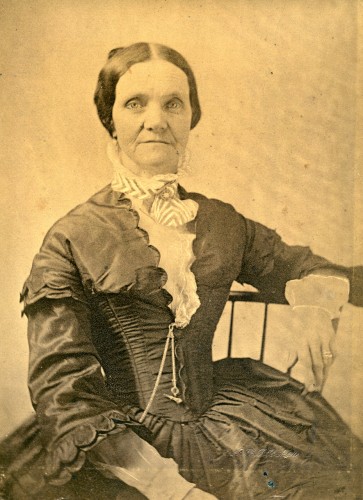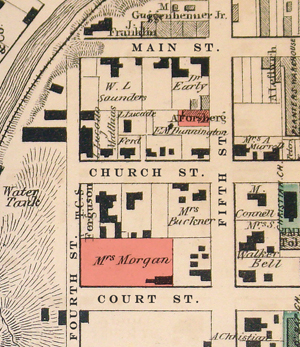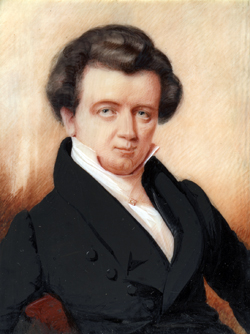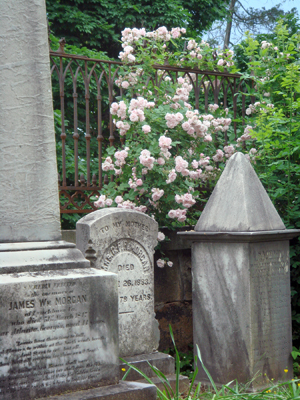
Caroline Morgan
Photograph courtesy of Patti Hannah and Florence-Lauderdale Public Library Digital Archive (Florence, Alabama)
“Business only fit for men to pursue”
A Biography of Caroline Fitz Randolph Morford Morgan (1805–1883)
By Lynne Davis Spies, Volunteer Writer & Researcher
Born May 1, 1805 to a New Jersey family connected to the founding of Princeton University,1 Caroline Fitz Randolph Morford was the youngest of Stephen and Mary Hamilton Morford’s five children.2 She came to be characterized as one of the “great belles” in her day.3 Petite and lively, she caught the eye of Lynchburg native and medical student James William Morgan, whom she married on October 12, 1826, in Princeton, New Jersey.4 The couple established their residence in Lynchburg, living in the Morgan mansion located on property that extended from the corner of Court and Fifth Streets to “the Cliff of Black Water.”5 Between 1829 and 1841, Caroline bore eight children, including two sets of twins; however, five of those children died before they were eight years old, which doubtless brought great sadness to the family. The three who survived were James William Morgan, Jr. (1834-1924), Mary Elizabeth (“Mollie”) Morgan (1839-1918), and Alexander Morford Morgan (1841-1913).
For a woman of her era and station, Caroline lived a typical life filled with family, church, and charitable work. Married to a wealthy tobacconist (her husband apparently never practiced medicine) whose family had holdings throughout the South, including a plantation, Morgavin, in Yalobusha, Mississippi, she was active in the Court Street Methodist Episcopal Church, a member and officer of the Dorcas Society (a Methodist benevolent organization), and Second Directress (Vice-President) of the Ann Norvell Orphan Society, giving her energies to help the poor and disadvantaged: “She delighted to give—finding it a most blessed privilege to aid with the means in her hands in every good work.”6

Residences of Caroline Morgan and her daughter Mollie Forsberg, 1877
Courtesy of Jones Memorial Library
Caroline’s life, however, changed significantly and her character departed from the conventional script of a wealthy married woman in the nineteenth-century South7 when her husband of twenty years died. James William Morgan died, perhaps of yellow fever, on March 31, 1847, on the train as he was returning from “a tour of his holdings in the Deep South.”8 A widow at 42, having lost two children only three years beforehand and with three young children at home, Caroline clearly suffered great sorrow. Her burden of grief was compounded by the burden of inheritance. Her husband left her a great deal of “real, slave, and personal property situate in the town of Lynchburg” as well as dower interest in many more properties in Lynchburg and in Mississippi.9 It is apparent that she felt keenly the responsibility of her wealth, soon taking an active interest in her holdings, which was perhaps somewhat uncharacteristic for a woman of her time and station.Some of the more intriguing aspects of Caroline’s life after her husband’s death emerge as a result of her re-marriage on July 12, 1849, to Dr. William Perry Allison, a Mississippian, who was between ten and eighteen years younger than she.10 Caroline met Allison during a stay at the Morgan plantation in 1848 when he was called in to treat Morgavin’s overseer, his family, and numerous slaves for scarlet fever. Details of this relationship survive in some remarkable documents: several love letters; an “Indenture” (a legal document which can be characterized in today’s terms as a prenuptial agreement preserving Caroline’s interest in and control of her property, her income, and her financial security); and a sensational “Resolution,” written by Allison largely to justify his behavior and demonize Caroline’s as their marriage broke apart.11 Much can be inferred, albeit cautiously, about Caroline and William Allison’s relationship from these documents.

James William Morgan (1803-1847)
Courtesy of Lynchburg Museum System
The love letters written shortly before their marriage demonstrate real affection between the two. Allison writes of his feelings as “the fire, the inconceivable heat that warms my bosom,” but he also betrays anxiety: “I will not harbor the thoughts of your being estranged [from me] by any possible influence,” an apparent reference to another suitor and to some of Caroline’s connections who disapproved of the relationship. For her part, Caroline addresses Allison as “My own Willie,” and speaks of ladies’ malicious gossip about her having another suitor; she assures him, though, that “[o]f one thing I am positive, I only love you. I never intend to marryanyone but you.”12 According to Allison, Caroline proposed marriage to him—a rather unusual move for a woman in the nineteenth century!
In spite of love between Allison and Caroline, the marriage was short-lived and somewhat tempestuous. It seems to have foundered at least in part because of Caroline’s sense of her own authority and independence. Among Allison’s complaints in his “Resolution” are accusations that Caroline was bad tempered; took others’ advice over his; and, in response to his slapping “very lightly” one of her sons, told him “[she] would never sleep with [him] again.” While Allison willingly signed the prenuptial “Indenture” in which Caroline preserved her financial security, his complaints against her are summarized in his “Resolution” when he writes:
I think I see the cause of the whole unhappiness but it is not in my power to apply the remedy [. . .] while you have to attend to business only fit for men to pursue. Never while you take upon yourself the management of the Estate, will you be happy or make your husband so [. . .]. What must everybody think of a husband of such a woman if they know she has one?
In other words, he felt emasculated. According to Allison’s great grand-niece, “Caroline was quite a lady for her times [. . .] who wanted someone to ‘look like’ the head of the house while she continued to be in complete control.”13
After their divorce in the 1850s,14 Caroline resumed her life in Lynchburg as Mrs. C. F. R. Morgan, discarding entirely Allison’s name. Only through legal documents as well as federal census records do a few details emerge about Caroline in the approximately thirty years between the divorce and her death. She continued to be involved in legal transactions related to her first husband’s and father-in-law’s estates. By 1860, her daughter, Mollie, had married,15 and her two sons, James, Jr. and Alexander,16 were living with her in the Morgan mansion. Eventually, James moved to Florence, Alabama, where he married Annie Rowell.17 Along with many others, Caroline suffered financial reverses after the Civil War, which one document delicately referred to as a change in her “pecuniary condition”;18 yet, she lived to be “one of the oldest residents of Lynchburg” who was “highly esteemed by all.”19

Morgan Plot in Old City Cemetery
Courtesy of Southern Memorial Association/Old City Cemetery, Photo by Ted Delaney
Caroline died on June 26, 1883. Her funeral was held at Court Street Methodist Episcopal Church, where she had been a member since coming to Lynchburg as a young bride, and she was buried in the Morgan family plot in the Old City Cemetery. “In Memoriam,” a newspaper piece published several days after her death, alludes briefly to the turbulence of Caroline’s life: “So closes the long and checquered years [sic]; so ends the drama of a life, many shifting scenes of which have been very dark and sorrowful….” But the same piece also speaks of her as “a person of uncommon mind, and many high and noble qualities.”20 It is clear that Caroline Fitz Randolph Morford Morgan was a spirited, independent woman who was, in many ways, ahead of her time.
Are you a descendant of Caroline Morgan? Do you have a picture of Caroline? Can you add anything else to her biography? If so, we want to talk to you! Please contact us by calling (434) 847-1465 or e-mailing occ@gravegarden.org.
NOTES:
1. A Morford family document records Caroline’s birth year as 1803. See Forsberg family CD-ROM in the Lynchburg Museum or Old City Cemetery.?
2. Caroline’s maternal grandmother, Sarah Manning Hamilton, was the granddaughter of Nathaniel FitzRandolph, “the son of an original 17th-century Quaker settler of Princeton,” who was “[m]ore than any other citizen of the town […] responsible for raising the money and land the Trustees required of the townspeople of the place where the College of New Jersey was to be located.” See the photocopy of Princeton University Development Office material in the Morford Correspondence binder, Lynchburg Museum. My thanks go to Sue Hodgdon, who generously shared her Forsberg family genealogical research with me; that research established the precise relationship between Caroline and Nathaniel FitzRandolph.?
3. John Frelinghuysen Hageman, History of Princeton and Its Institutions. 2 vols. (J.B. Lippincott, 1879), 191-192. Princeton University was originally named The College of New Jersey.?
4. Lynchburg Virginian, Oct. 19, 1826. James William Morgan was the son of Elizabeth K. (1780-1823) and William Morgan (1769-1842), one-time Mayor of Lynchburg who had extensive land holdings throughout the South and “was among the early founding fathers of Lynchburg,” according to his granddaughter, Hilda Forsberg Davis. (See her memoir “My Soldier-Father,” typescript in the Jones Memorial Library file FF1384 and in the Morgan Correspondence binder in the Lynchburg Museum.) James William Morgan studied medicine at the College of New Jersey/Princeton University. As for Caroline’s petite stature, although no photographs or paintings of her are known to exist, her daughter, Mary Elizabeth (Mollie) was quite petite, and, at her death, one writer noted that the size of Caroline’s coffin was “almost as small as a child’s.” See “In Memoriam” in the Morgan Correspondence binder at the Lynchburg Museum.?
5. “Indenture” recorded in the Clerk’s Office, Lynchburg, Aug. 18, 1849, in the Old City Cemetery file for Caroline M. and James W. Morgan.?
6. “In Memoriam,” Morgan Correspondence binder, Lynchburg Museum.?
7. See Jones Memorial Library file PAM 1453 for a summary of the virtues of the ideal Southern woman in “A Tribute to Mrs. Lucy Mina Otey” by Sallie Daniel Halsey (The Southern Literary Messenger: A Literary Monthly Devoted to Southern Literature, History, and Education 1, no. 3 [1895]). Among other qualities, she should be Christian and involved in benevolent work, her home should be neat and hospitable, and she should have the capacity “`of making a rainy day look gay.’”?
8. Lucy Harrison Miller Baber, Behind the Old Brick Wall: A Cemetery Story, 2nd ed. Research and Writing by Evelyn Lee Moore. (Lynchburg: Warwick House, 1998), 60. In the Morgan Correspondence binder in the Lynchburg Museum, an entry on a page titled “Family Record” records his cause of death as “apoplexy.” Whatever the cause, as Baber records, James William Morgan was buried outside Atlanta, not in the Old City Cemetery.?
9. Much of her inheritance is catalogued in the “Indenture.” Further evidence of her interest and involvement in business relating to it appears in various legal documents in the Lynchburg Clerk’s Office and in the Caroline M. and James W. Morgan file in the Old City Cemetery.?
10. According to the 1870 Federal Census and “Public Member Family Trees” on ancestry.com, Allison was born in 1821. As there is disparity in records about Caroline’s birth date, so is there a disparity in records about William P. Allison’s birth date. His birth year is recorded as 1815 or 1821, which means that at the extreme ends, if Caroline was born in 1805 and William in 1815, the gap would have been ten years; if she was born in 1803 and he in 1821, the gap would have been eighteen years.?
11. See “Indenture”; also, “Resolution of Dr. William P. Allison to Caroline F.R. Morgan Allison, 1848-1855,” in the Old City Cemetery file for Caroline M. and James W. Morgan.?
12. Letters, Caroline M. and James W. Morgan file in the Old City Cemetery.?
13. Virginia Allison Adams, e-mail to Ted Delaney, Archivist and Curator, Old City Cemetery, May 25, 2002, in the Old City Cemetery file for Caroline M. and James W. Morgan.?
14. Documentation of the divorce has yet to be found, but from other information, it appears that they were divorced sometime between 1852-1858. Allison family history suggests 1852; the original handwritten copy of William Allison’s “Resolution” is undated; in documents in the Lynchburg Clerk’s Office, legal transactions during 1857-58 list her as Caroline Allison, and then revert back to Caroline Morgan. In 1860 federal census documents, she is listed as C.F.R. Morgan while William Allison lived in Suwanee County, FL.?
15. Mollie’s life is also quite interesting and can be read about not only in Old City Cemetery files but also in the Spring 2009 Muse News, the Lynchburg Museum system’s newsletter, which chronicles the search for original photos of Mollie and her second husband, Col. Ludwig August Forsberg. That search resulted in the Museum’s learning of the existence of four binders of original documents relating to family history, including original photos of Mollie; these invaluable documents were donated in 2009 to the Lynchburg Museum by Mollie’s great-grandchildren, Margaret Forsberg Drost and Richard Hodgdon. I am grateful to the family and to the Museum for having been permitted to read the original versions of documents in the binders. Their contents are also now available in electronic form at the Museum.?
16. Alexander Morford Morgan lived with his mother until her death, then resided in the City Hospital, essentially an almshouse, for nearly 30 years before he, too, died. Apparently, Caroline’s declining fortunes after the Civil War made this move necessary; however, with a wealthy sister, Mollie Morgan Otey Forsberg, in Lynchburg, and a well-to-do brother, James William Morgan, Jr., in Alabama, it seems odd that he was not in a private hospital. It is clear from an 1886 letter written by one of Alexander’s young nephews, Carl Forsberg, to his brother Rudolf Forsberg that Alexander suffered from some disability, as Carl renders his “Uncle Alex’s” comment after having been chased by a dog as “’I mlade a mlotion at him and he run.’” (See the August & Mollie Forsberg Correspondence binder in the Lynchburg Museum.) He died in 1913, and is buried in the Morgan plot, but no stone marks his grave. The Lynchburg City Directory for 1885-86, two years after Caroline’s death, lists Alexander as residing at the Morgan property on Court Street between 4th and 5th Streets. In the 1887-88 City Directory, the mansion is listed as the property of Zacharias W. Carwile. By 1896, the Morgan property on Court St. apparently had been torn down since that year’s City Directory lists no buildings beyond 411 Court St.?
17. James William Morgan, Jr. and his wife had two children, James William Morgan III, who died young, and a daughter, Carrie Morgan Hood, with whom he lived when he died in Florence in 1924.?
18. “In Memoriam,” Morgan Correspondence binder, Lynchburg Museum.?
19. Lynchburg Virginian, June 28, 1883.?
20. Morgan Correspondence binder, Lynchburg Museum.?
